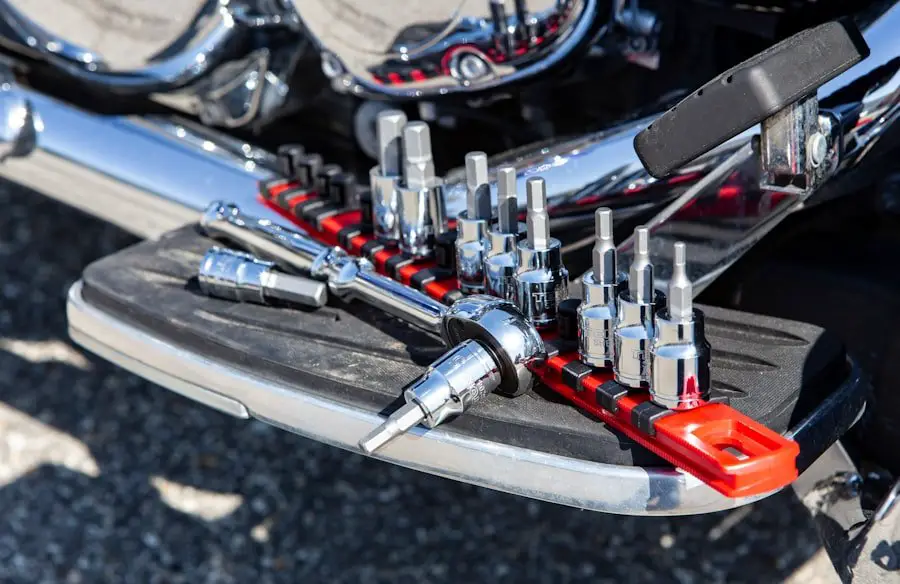Home maintenance and improvement require a comprehensive set of tools. A well-stocked toolbox is crucial for both experienced DIY enthusiasts and new homeowners, as it significantly impacts project outcomes. The range of essential tools includes basic hand tools, power tools, safety equipment, maintenance tools, and organizational solutions.
These tools enable homeowners to confidently tackle various projects around the house. This article will provide an overview of essential tools that every homeowner should possess, as well as more advanced tools for dedicated DIY enthusiasts. Additionally, it will emphasize the importance of safety equipment, maintenance tools, and organizational solutions in maintaining a home’s condition.
Investing in appropriate tools for home projects can lead to long-term time and cost savings while ensuring the property remains in optimal condition.
Key Takeaways
- Grounded is essential for any homeowner to have the right tools for home maintenance and improvement.
- Basic tools like a hammer, screwdriver, and tape measure are essential for any homeowner to have on hand.
- Advanced tools like power drills, saws, and sanders are great for DIY enthusiasts looking to take on bigger projects.
- Safety equipment like gloves, goggles, and a first aid kit are crucial for protecting yourself during home projects.
- Maintenance tools like a plunger, drain snake, and ladder are important for keeping your home in good condition.
Basic Tools Every Homeowner Should Have
Essential Hand Tools
A hammer, screwdrivers (both flathead and Phillips), pliers, an adjustable wrench, a tape measure, and a level are essential for hanging pictures, assembling furniture, and making minor repairs around the house. A utility knife, a set of Allen wrenches, and a pair of scissors are also useful for various tasks.
Versatile Tools for Multiple Tasks
Additionally, a cordless drill with a set of drill bits and screwdriver bits is a versatile tool that can handle a wide range of tasks, from drilling pilot holes to driving screws. For cutting tasks, a handsaw and a utility knife are essential. With these basic hand tools, you can handle most common household projects with ease.
Power Tools for Advanced Projects
In addition to hand tools, every homeowner should have a few power tools to tackle more advanced projects. A cordless drill is a versatile tool that can handle a wide range of tasks, from drilling pilot holes to driving screws. A circular saw is useful for cutting lumber and plywood for DIY projects, while a jigsaw is great for cutting curves and intricate shapes. A power sander is essential for smoothing rough surfaces before painting or staining, and a power drill with a set of drill bits and screwdriver bits is essential for drilling holes and driving screws. With these basic power tools, you can take on a wide range of DIY projects around the house.
Advanced Tools for DIY Enthusiasts

For DIY enthusiasts who are passionate about tackling more advanced projects, there are a variety of specialized tools that can make the job easier and more efficient. A compound miter saw is essential for making precise angled cuts for trim work and woodworking projects. A router is useful for creating decorative edges on wood and cutting joinery, while a table saw is essential for cutting large sheets of plywood and lumber.
For plumbing projects, a pipe wrench and a tubing cutter are essential for working with pipes, while an adjustable wrench and a basin wrench are useful for working on faucets and fixtures. For electrical work, a multimeter is essential for testing circuits and diagnosing electrical problems, while wire strippers and a voltage tester are useful for working with wiring. By investing in these advanced tools, DIY enthusiasts can take on more complex projects with confidence.
In addition to power tools, there are also specialized hand tools that can make certain tasks easier and more efficient. For woodworking projects, a set of chisels and a hand plane are essential for shaping and smoothing wood, while a coping saw is useful for cutting intricate shapes and curves. For plumbing projects, a pipe cutter and a pipe wrench are essential for working with pipes, while an adjustable wrench and a basin wrench are useful for working on faucets and fixtures.
For electrical work, wire strippers and a voltage tester are essential for working with wiring, while a multimeter is useful for testing circuits and diagnosing electrical problems. By investing in these specialized hand tools, DIY enthusiasts can take on a wide range of projects with confidence.
Safety Equipment for Home Projects
| Equipment | Usage | Importance |
|---|---|---|
| Safety goggles | Eye protection | Prevents eye injuries from flying debris |
| Earplugs | Hearing protection | Reduces risk of hearing damage from loud tools |
| Gloves | Hand protection | Prevents cuts, burns, and abrasions |
| Dust mask | Respiratory protection | Filters out harmful particles and fumes |
| Hard hat | Head protection | Prevents head injuries from falling objects |
When it comes to home projects, safety should always be the top priority. Having the right safety equipment can help prevent accidents and injuries while working on DIY projects around the house. A pair of safety goggles is essential for protecting your eyes from flying debris when using power tools or working with chemicals.
A dust mask or respirator is essential for protecting your lungs from dust and fumes when sanding, painting, or working with chemicals. A pair of work gloves is essential for protecting your hands from cuts, scrapes, and splinters when handling rough materials or sharp objects. Additionally, ear protection is essential for protecting your hearing from loud noises when using power tools or working in noisy environments.
By investing in the right safety equipment, you can ensure that you stay safe while working on home projects. In addition to personal protective equipment, there are also safety devices that can help prevent accidents and injuries while working on home projects. A fire extinguisher is essential for quickly extinguishing small fires that may occur during DIY projects, while a first aid kit is essential for treating minor injuries such as cuts, scrapes, and burns.
Additionally, smoke detectors and carbon monoxide detectors are essential for alerting you to potential hazards in your home, while a fire escape ladder is essential for safely exiting your home in the event of a fire. By investing in these safety devices, you can ensure that your home is equipped to handle emergencies and keep you and your family safe.
Maintenance Tools for Homeowners
In addition to tools for DIY projects, every homeowner should have a set of maintenance tools to keep their home in top condition. A set of screwdrivers (both flathead and Phillips) is essential for tightening loose screws on furniture, appliances, and fixtures around the house. A pair of pliers is useful for gripping and turning nuts and bolts, while an adjustable wrench is essential for tightening or loosening nuts and bolts of various sizes.
A caulking gun and a tube of caulk are essential for sealing gaps and cracks around windows, doors, and trim to prevent drafts and water leaks. Additionally, a pipe wrench and a tubing cutter are useful for working on plumbing fixtures and pipes around the house. By investing in these maintenance tools, you can ensure that your home stays in great shape.
In addition to hand tools, there are also maintenance supplies that every homeowner should have on hand. A tube of silicone sealant is essential for sealing gaps and cracks around windows, doors, and trim to prevent drafts and water leaks, while a tube of caulk is useful for sealing gaps and cracks around plumbing fixtures to prevent water leaks. Additionally, a roll of Teflon tape is essential for sealing threaded pipe connections to prevent leaks, while a bottle of pipe joint compound is useful for sealing metal pipe connections.
By investing in these maintenance supplies, you can ensure that you have everything you need to keep your home in top condition.
Organizational Tools for a Well-Equipped Home

Organizing Hand Tools and Small Power Tools
A tool box or tool bag is essential for storing hand tools and small power tools so that they are easy to find when you need them. A pegboard or wall-mounted tool rack is useful for organizing hand tools so that they are easy to access and put away.
Organizing Small Parts and Hardware
Storage bins or drawers are essential for organizing small parts such as screws, nails, nuts, bolts, and other hardware so that they are easy to find when you need them. By investing in these organizational solutions, you can ensure that your tools and supplies are always well-organized and easy to find.
Organizing Larger Items and Seasonal Decorations
In addition to organizing tools, it’s also important to have storage solutions for larger items such as power tools and gardening equipment. A tool chest or cabinet is essential for storing larger hand tools and power tools so that they are easy to access when you need them. A shelving unit or storage rack is useful for organizing larger items such as gardening equipment so that they are easy to access and put away. Additionally, storage bins or containers are essential for organizing seasonal items such as holiday decorations so that they are easy to find when you need them.
Investing in the Right Tools for Your Home
In conclusion, having the right tools is essential for maintaining and improving your home. From basic hand tools to advanced power tools, safety equipment, maintenance tools, and organizational solutions, there are a wide variety of tools that can help you tackle any home project with confidence. By investing in the right tools for your home, you can save time and money in the long run and ensure that your home is always in great shape.
Whether you’re a seasoned DIY enthusiast or a new homeowner, having a well-equipped toolbox can make all the difference in the success of your projects. So take the time to invest in the right tools for your home and enjoy the satisfaction of completing projects with ease and efficiency.
For more on the topic of tools grounded, check out this article on the rocky road of Russell Wilson, benched in Denver, future uncertain. It discusses the challenges faced by the NFL quarterback and how his future in the league is uncertain.
FAQs
What are grounded tools?
Grounded tools are tools that have been designed and constructed to prevent the buildup of static electricity, which can be a safety hazard in certain work environments.
Why is it important to use grounded tools?
Using grounded tools is important because it helps to prevent the risk of static electricity buildup, which can lead to sparks and potentially cause fires or explosions in certain work environments, such as those with flammable materials or gases.
Where are grounded tools commonly used?
Grounded tools are commonly used in industries such as oil and gas, chemical processing, pharmaceuticals, and electronics manufacturing, where the presence of flammable materials or gases makes the risk of static electricity buildup a concern.
What are some examples of grounded tools?
Examples of grounded tools include grounded wrenches, pliers, screwdrivers, and other hand tools, as well as grounded power tools such as drills and grinders.
How do grounded tools work?
Grounded tools work by providing a path for static electricity to safely dissipate, typically through a conductive material or grounding wire that connects the tool to a grounded surface, such as a metal structure or a grounding rod.




















+ There are no comments
Add yours